Model Species


Model Species

In our lab, as in many other behaviour, evolution and ecology labs, the focus is not so much on the biology of our specific study organisms as it is on how these organisms can help us understand biological phenomena and processes that have broad relevance across species and taxa. This means that our study species are model systems, chosen because of their potential to help us answer particular questions.
That said, I have to admit that one easily develops a certain fondness for the species one studies, once one gets to know more and about it, and starts understanding its biology at greater depth. I’ve really liked my study organisms, be they shags, bluethroats, two-spotted gobies, or coral reef fishes. When one observes behaviour, one gets a real feel for the personalities of each and every fish or bird, and starts seeing them as the individuals they are. I really like that.
Below are some info about model systems (species) that we currently work with.
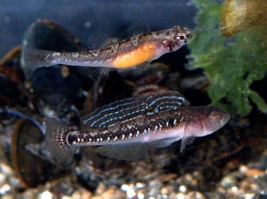
Two-spotted goby (N: tangkutling)
Gobiusculus flavescens
This little (4-5 cm long) marine fish is likely the most common fish species in shallow waters along Norway’s (and W Europe’s) rocky shores, and a keystone species in Scandinavian coastal ecosystems. It is the main food of juvenile coastal cod, and a main predator on copepods. The species is semi-pelagic, forming shoals outside the breeding season and when feeding, but with males solitarily defending their nests during the breeding season.
Two-spotted gobies normally live for only one year. During the breeding season (spring to mid summer), they mostly live among the algal vegetation at <5 m depth. Males defend nests in mussels (often blue mussels) or on leaves of Laminaria or Saccharina algae, in which typically 2-4 females (sometimes more) deposits clutches of eggs. Individual females typically lay 1000-1500 eggs, but when many females lay in the nest of the same male it can hold up to 7000 eggs or more. Males care for these eggs for 1-3 weeks until hatching, fanning oxygen-rich water onto the eggs, cleaning away detritus and parasites, and depending the nest against predators. Both males and females actively court the other sex, and both can be choosy with respect to mates. Both males and females can mate and reproduce repeatedly over the course of their single breeding season. The social system of the species is interesting because the relative abundance of breeding-ready males and females changes dramatically over the breeding season, from an excess of males early on to an overabundance of females by the end of the season.
We’re interested in the species for mainly two reasons: (1) both sexes have bright colours but, as the the photo shows, in different ways, making it excellent for studies of sexual selection not only in males but also in females. (2) the species also has uniquely dynamic sex roles, being the only know vertebrate to shift from conventional sex roles (males compete for matings) to reversed sex roles (females compete for matings) over the course of a single breeding season. This flexibility makes it exceptionally suitable for studies of the dynamics of sexual selection and animal signaling.
Probably all Norwegians who have spent time by the coast has seen two-spotted gobies underneath some pier or elsewhere in the shallows, among the brown algae. But most would not know what they’ve seen, how beautiful they are, or how important they are in the coastal ecosystems. This tells something about how little we know the marine environment and its creatures, as compared to life on land.
Key references:
Amundsen, T. & Forsgren, E. (2001). Male mate choice selects for female coloration in a fish. Proceedings of the National Academy of Sciences, USA, 98: 13155-13160.
Forsgren, E., Amundsen, T., Borg, Å.A. & Bjelvenmark, J. (2004). Unusually dynamic sex roles in a fish. Nature, 429: 551-554.
Sand goby (N: sandkutling)
Pomatoschistus minutus
Common goby (N: leirkutling)
Pomatoschistus microps
Painted goby (N: bergkutling)
Pomatoschistus pictus
Glass goby (N: glasskutling)
Aphia minuta
Black goby (N: svartkutling)
Gobius niger
With the exception of the glass goby, these gobies are all benthic species. That means that they spend most of their time at or near the bottom, where they feed, mate and have their nests in mussels (mostly) that lay on the bottom. They are all highly abundant and as such ecologically important. They are typically found in shallow bays, with the common goby often inhabiting the finest substrate (silt, clay) and thus the shallowest parts, the sand goby intermediate in substrate (sand) and depth, and the painted goby where there is more gravel. The black goby can be found on sand and gravel.
The glass goby is special in being one of a few truly pelagic gobies in northern waters. The species is almost entirely transparent, with internal organs readily visible. It occurs in shoals in shallow water during the breeding season, but little is known about its biology.
The general biology of all these gobies is similar to that of the two-spotted goby: eggs are deposited on some substrate (mostly mussels) and cared for by the male until hatching. With the exception of the black goby, which can live for several years, all the species normally live for only one year. The species are typically 3-6 cm long apart from the black goby which can become >10 cm long.
While the two-spotted goby (above) has been the main model organism of our lab, some of the other Nordic goby species are also extensively used as model species in behaviour, ecology and evolution. This applies in particular to the sand goby and the common goby, which have been and are central model organisms in the labs of our collaborators Kai Lindström (Åbo, Finland), Carin Magnhagen (Umeå, Sweden) and Lotta Kvarnemo (Göteborg, Sweden). The sand goby was also the main study organism of Elisabet Forsgren of our lab (NINA, Trondheim, Norway). We are involved in complementary work on all the goby species mentioned above, to study sexual ornamentation, genetic mating systems and related issues, across species and study sites. Much of these activities result from a Nordic Goby Network involving labs in Trondheim, Bergen, Åbo, Helsinki, Umeå, Göteborg, and with links to labs in Denmark and Iceland.
Key references:
Forsgren, E., Kvarnemo, C. & Lindström, K. (1996). Mode of sexual selection determined by resource abundance in two sand goby populations. Evolution, 50: 646-654.
Svensson, P.A., Blount, J.D., Forsgren, E. & Amundsen, T. (2009). Female ornamentation and egg carotenoids of six sympatric gobies. Journal of Fish Biology, 75: 2777-2787.
Coral Reef Fishes
Recently, we have initiated a project to study reef fish coloration and related issues of reef fish diversity, funded by the Research Council of Norway. This project is likely to make use of several model species to address why reef fishes are so colourful. So far, our main model has been the damselfish Neoglyphidodon nigroris, but we may initiate work also on other damselfishes, and/or on gobies, blennies, wrasses or cardinalfishes.
Our work on reef fish coloration is conducted at Lizard Island Research Station, situated near the north end of the Great Barrier Reef, Australia.
It may surprising to many that it is largely unknown why coral reef fishes are so colourful. Sure enough, a number of ideas (hypotheses) have been put forward, but none of these have extensive empirical support. Traditionally, the perhaps most widely accepted explanation has been that the colours are to signal species identity. On a small reef, there may be several hundred species of fish; coral reefs have by far the highest diversity of vertebrates of any natural habitat, be it terrestrial or aquatic (the diversity per area is far higher than the Amazon, believe it or not). So under such circumstances, it is probably good to be able to spot potential mates easily, among all the other fish. Hence striking colours to tell who you are, according to this hypothesis. A sound idea, but as already told, the support for it is limited and there are a number of phenomena that doesn’t fit well with it.
What else can it be, then? Suggestions include that the colours signal that the species is unhealthy food (aposematic signaling), and that the colours are actually cryptic and provide camouflage, despite being conspicuous to us. Both these ideas have received some empirical support, but none of them seem likely to be generally applicable to reef fish coloration.
In short, we don’t really know why reef fishes are so colourful. So time to find out! (OK, that may sound a bit optimistic, but that’s actually what we’re after). We’re realistic enough to realize we cant get all the way, but hope we can contribute a little to a better understanding of the colour splendour of reef fishes.
Black-and-gold chromis (N: frøkenfisk)
Neoglyphidodon nigroris
The damselfishes (Pomacentridae) is one the most families of reef fishes, including several hundred species. Many damselfishes defend small territories in the coral structures. Such territories often have several function - as shelter, feeding grounds, and as a place to breed. Many species, including the black-and-gold chromis Neoglyphidon nigroris, have small patches of algae growing in the territories and feed both on the algae and on organisms living on the algae. N. nigroris seems to typically inhabit habitat with quite a bit of structure, often with a mixture of live and dead coral, quite often dominated by Porites or Acropora corals. It seems primarily to live at 1-4 m depth.
We chose the black-and gold chromis a suitable model species not because it is the most extravagantly colourful fish on the reef (it isn’t), but because it has a sort of conspicuous coloration that is both sufficiently distinct and sufficiently simple to allow reliable quantification. For our purposes it is also interesting that males and females have very similar coloration - the two sexes can only be distinguished by examination of their genital structures (and of course internally from gonads). There is extensive individual variation in coloration.
The species adjust reasonably readily to the lab and perform natural behaviours there, including aggressive displays. Field studies (so far unpublished) have shown that both sexes defend territories, and the species is quite aggressive against conspecifics of both sexes.
The black-and-gold chromis attains adult coloration at a length of 3-4 cm, and grows to 10-15 cm. It is not known how old these fish can get, but guesses (from studies of other damselfish) are in the range of 4-8 years. In general, very little detail is known about this fish - as is also the case for the majority of reef fishes. However, it is known to lay its eggs in crevices in the coral, and we believe but do not know that several females can spawn in the nest of a single male (as in the gobies). Also like gobies, the clutch is cared for by the male until hatching.
Key references:
None - we have only recently initiated this work and nothing is yet published.
Bluethroat (N: blåstrupe)
Luscinia svecica
During the 90s, the main model organism of our my lab was the bluethroat, a small (ca 20 g) passerine inhabiting montane regions of Fennoscandia (and Russia). We studied bluethroats in the valley Øvre Heimdalen near Jotunheimen in central south Norway (about 1100 m.a.s.l.). Our base was the small and self-serviced research Øvre Heimdalen Field Station, owned by the University of Oslo.
The bluethroat is insectivorous, and accordingly migrates to warmer climates during winter. Wintering grounds are not well established, but seem to include middle and far east countries all the way to India. Bluethroats arrive to the breeding grounds in Øvre Heimdalen in early or mid May, the males generally arriving a few days before the females. Because of the short summer in the mountains, breeding commences within short unless the weather conditions are particularly unfavourable.
Shortly after arrival, the males establish territories, and start advertising for mates (and defending their territories vs intruding males) from elevated positions centrally located in the territories. Male bluethroats are among the best singers among Nordic passerines, which has given the species the nickname of «nightinggale of the mountains». Females visit the territories of males to find a suitable mate. Once a pair is established, the building of a nest at the ground (often under a dwarf birch or juniper bush) commences. Building takes up to a week, after which a clutch of typically 4-6 eggs are laid. Males guard their mates during the fertile period just before and a bit into egg-laying. Clutches are incubated by the female for just under two weeks. Once hatched, the nestlings are fed by both parents, at similar rates. Within <2 weeks the nestlngs reach adult body mass, and leave the nest. However, they are escorted and partly fed by their parents for another few weeks.
Like many passerines, bluethroats are often unfaithful to their partners, with about half of the nests having one or more egg fertilized by a cuckolder male, and with about one third of all nestlings being extra-pair.
The bluethroat is among the most elaborately ornamented birds in Scandinavia, and as such an excellent model for studies of sexual selection. The extensive parental care also makes it suitable as a model for parental care and the relationship between care and sexual selection. It also allows studies of parent-offspring dynamics, and of sibling competition. These issues have been central to research on the species by our lab and collaborators.
Our team is currently not conducting field studies of bluethroats, but bluethroat studies in Øvre Heimdalen is continued by the a team from the Natural History Museum, University of Oslo, led by Jan T. Lifjeld and Arild Johnsen. Our Trondheim team used to collaborate with the Oslo team, and we still have work to do with bluethroat data sets and experiments not yet published.
Key references:
Amundsen, T., Forsgren, E. & Hansen, L.T.T. (1997). On the function of female ornaments: male bluethroats prefer colourful females. Proceedings of the Royal Society of London, B, 264: 1579-1586.
Andersson, S. & Amundsen, T. (1997). Ultraviolet colour vision and ornamentation in bluethroats. Proceedings of the Royal Society of London, B, 264: 1579-1586.
Smiseth, P.T., Bu, R.J., Eikenæs, A.K. & Amundsen, T. (2003). Food limitation in asynchronous bluethroat broods: effects on food distribution, nestling begging and parental provisioning rules. Behavioral Ecology, 14: 793-801.
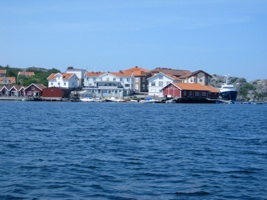
Male (below) and female (above) two-spotted gobies in mutual courtship. Two-spotted gobies have uniquely dynamic sex roles, making them ideal model systems for sex role research.
We study gobies at Sven Lovén Centre for Marine Sciences - Kristineberg, Sweden (photo), and at other marine research stations in the Nordic countries.
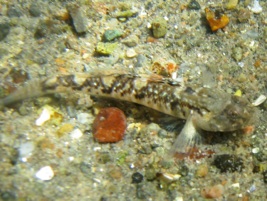
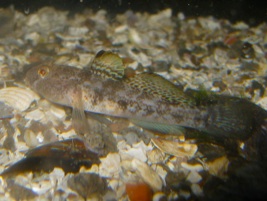
Painted goby by Blåbergsholmen near Kristineberg. The benthic gobies can be hard to separate visually. However, male painted gobies have colourful dorsal fins.
Black goby in aquarium at SLC - Kristineberg. The dark spot on the first dorsal fin is diagnostic.
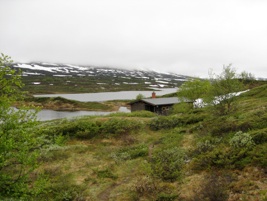
Øvre Heimdalen Field Station, situated in the Øvre Heimdalen valley east of the Jotunheimen mountain range. Lake Øvre Heimdalsvann in the background.
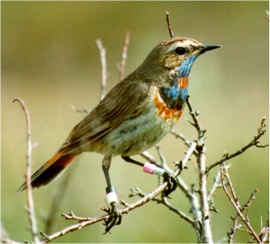
Male bluethroat, Øvre Heimdalen. The colour bands allow individual identification. (Photo: Bjørn Bjerke, University of Oslo).


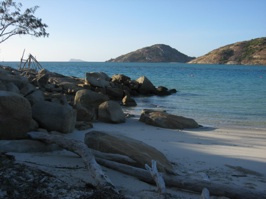
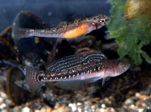
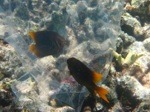
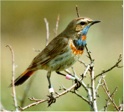
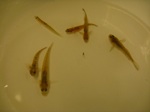
Two-spotted gobies, a small and abundant (& beautiful!) marine fish that is currently the main model species of our lab.
Other Nordic gobies (you won’t spot the difference but I think there’s 4 or 5 species here) that we study in collaboration with Nordic Goby Network labs.
The black-and-gold chromis (a damselfish) that we study at the GBR, Australia. The photo shows a free-living fish interacting with one in a plastic bag during an experiment.
The bluethroat, during the 90s the main model species of our lab and one that we still work with, though currently not in the field. Photo: Bjørn Bjerke.
Two-spotted goby clutch in a blue mussel (the mussel is taken on land and opened). A typical clutch may hold 3-4000 eggs, laid by 2-6 females. We believe but don’t know for sure that blue mussels are preferred nest substrates. The other typical nest substrate, and likely a more common one, is kelp leaves (mainly of sugar and finger kelp Laminaria digitata).

Two-spotted goby male in sugar kelp (Saccharina latissima) forest. Such kelp forests dominate moderately exposed rocky shores in W Scandinavia, but have suffered severe declines in recent years, especially in S Norway, likely as a result of eutrophication and climate change. The two-spotted goby is the most numerous fish species in this habitat, and the only species that breeds on the sugar kelp.
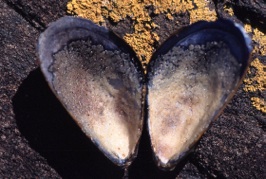

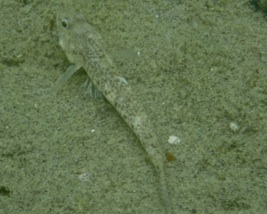
Sand goby in Smalsund by Kristineberg. You may not spot it, but those familiar with the sand goby (like Elisabet) will tell you it has a beautiful blue spot on its first dorsal fin. The species has a more elongate body than the other benthic gobies.
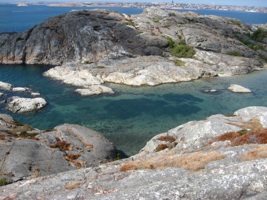
Smalsund, a nice place for observation of sand and common gobies. Smalsund separates the mainland and the Kristineberg research station from Blåbergsholmen (upper half). Two-spotted, painted and black gobies can be observed in bays on the other side of Blåbergsholmen.
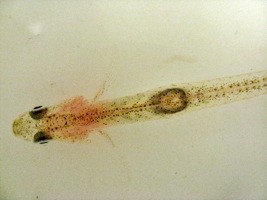
The strangely transparent glass goby, photographed in a beaker in the lab. This species is truly pelagic, but nests at the bottom like other gobies. Little is known about its biology.

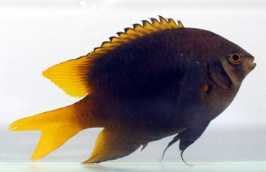

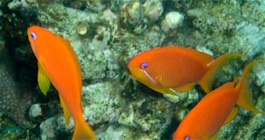
Coral reef fishes, like these anthiases (top) and the parrotfish (bottom), are often beautifullly coloured. Sometimes, but not always, are the colours equally striking in both sexes. Why do they have all this splendour? No-one really knows - we’d like to (contribute to) find out.
Lizard Island beach, with a view towards the lagoon where our field work is done. Lizard Island is situated near the north end of Australia’s Great Barrier Reef. More than 1200 fish species have been observed near the island, and the excellent Lizard Island Research Station is situated next to the beach, with indoor and outdoor labs, and living quarters.
The black-and-gold chromis Neoglyphidodon nigroris is a small territorial damselfish that is our current main model organism. We chose it because of its striking but at the same time easily quantifiable coloration. It is not the only model species of sexual selection with modest coloration - think about great tits, house sparrows and red-winged blackbirds.

Lizard Island lagoon. Most of the fish are found where the light (shallow) and dark (deeper) blue meet - that’s where the main coral structures are.

Sara Östlund Nilsson dives down to place an experimental fish (confined in a plastic bag) into the territory of an free-living fish.

Female bluethroats have variable throat coloration, with some looking almost like males. Our team has been interested in understanding why female bluethroats are sometimes so colourful. Photo: Roy Mangersnes.
Standardized photos of female bluethroat coloration, ranging from no colour (upper central) to nearly male-like (lower central). Male for comparison at lower right. From Amundsen et al. 1997.
